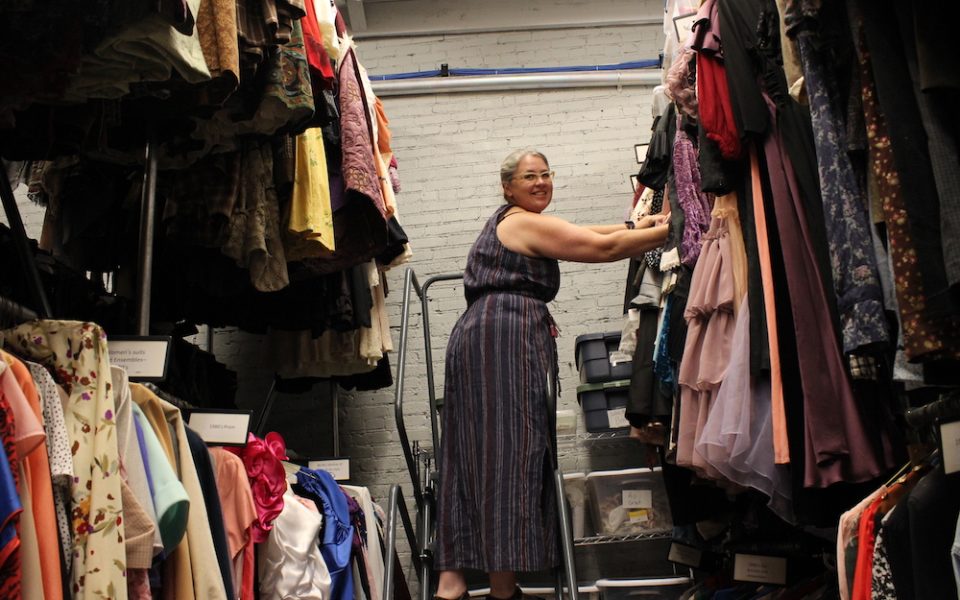It’s like walking into a library.
Each piece, each garment, each stitch
tells a different story, reflects a different era. Each has a
different author and purpose.
Twenty-thousand outfits fill the UNCG
costume warehouse, taking over the front room of what used to be
Addam’s Bookstore on Tate Street.
Flapper-style dresses from the 1920s
line the 10-foot high wardrobe racks next to rows of medieval
chainmail and ’60s peasant dresses.
“We have everything from monsters to
animals to fairies to religious robes and military uniforms,” says
Amy Holroyd, the costume supervisor for UNCG’s theater department.
“There’s pretty much everything.”
Holroyd has been the keeper of the
outfits for close to a decade and oversaw the moving and cataloguing
of the pieces when the collection moved from its previous home on
campus to its new location on Tate Street last summer. She says she’s
probably handled each individual item in the collection, which ranges
from accessories like socks and hats to larger pieces like dresses
and jackets.

Three levels and nine rows of clothes
tower in the 1,800 square-foot room that houses all the garments that
the university has made, bought or collected over the years.
According to Holroyd, 30-40 percent of the garments were made by
students for the school’s productions.
She says having the students make the
garments themselves gives them the necessary tools to take their
craft into the real world after graduation. But the biggest challenge
for her lately is that many students coming into the program don’t
seem to know how to sew.
“They don’t have home ec anymore
like they used to,” she says. “They come in completely, really
unable to use their hands like past generations have been able to do.
We are teaching them from the roots.”
She says that some of the students come
into the program after watching shows like “Project Runway” or
through cosplay. But Holroyd says that making pieces for theater is
different than regular fashion.
“It’s not just crafty sewing,”
she says. “We’re making garments that we hope get used in another
production later. We’re not making pieces that just go down the
runway.”
Jacquelyn
Whiteside, a rising senior at UNCG, understands the difficulties that
come with making garments for actors who will perform on stage.
“You’re designing for people with
all body types,” Whiteside says. “And you have to understand that
the pieces will move on stage.”
Whitehead, who is working on a
bachelor’s degree in drama, is the lead costume designer for an
upcoming production of Pippin, which opens in late September.
Sketches of Whiteside’s designs hang
from a bulletin strip in one of the sewing rooms in the same building
as the costume storage room.

Bright-red leotards with stringy fringe
for the women and dark trench coat outfits for the men give the
characters color and life on paper.
“I love seeing student designers
really pleased when a show is exactly how they imagined it,”
Holroyd says. “Or even watching an actor all of a sudden find their
character after putting on their costume. Sometimes they can’t
fully become the character until they get their costume on.”
After the shows, Holroyd says some of
the pieces get reused for other productions or are lent to other
theaters in the area. They don’t rent or sell them to the public,
however.
“If people want to see the pieces,
they have to come see the shows,” she says.
Sydney de Briel, who graduated with an
MFA from UNCG in 2016, now works as the resident costume designer for
Barter Players, a program within the Barter Theater in Abingdon, Va.
“I like telling stories through
colors and shapes and I didn’t know it could be a job until I got
to college,” says de Briel, who started out as an actor. “What I
was missing as an actor was the control over how the story was told.
I think of costume design as a need to create an accurate first
impression. Unlike a movie, people don’t really watch theater shows
more than once so you have one shot to be as engaging as possible.
Costume design does that in such a wonderful and tangible way.”
One of de Briel’s creations from her
time at UNCG hangs on a mannequin at the front of the costume storage
building. Bright-red fabric clings to the form, starting at the top
with a bedazzled mock turtleneck and cascading all the way down to
the floor where it pools like a puddle of lava. De Briel created the
piece for the character of Sally Bowles in the school’s production
of Cabaret a few years ago.
-

Amy Holroyd stands next to two pieces in the costume archives, both of which she worked on. The piece on the left was designed by Sydney de Briel. (photo by Sayaka Matsuoka) -

The storage spans 12-feet tall and has nine rows of costumes. (photo by Sayaka Matsuoka)
At any moment, the skin-tight dress
looks like it might slip off the mannequin and begin dancing,
strutting across the storage room floor, taking on the life and
personality of Bowles — sensual, strange and self-willed.
And that’s what de Briel intended.
“While everyone knows clothes,
costumes can be so much more,” she says.
Learn more about UNCG’s upcoming theater productions online here.
Join the First Amendment Society, a membership that goes directly to funding TCB‘s newsroom.
We believe that reporting can save the world.
The TCB First Amendment Society recognizes the vital role of a free, unfettered press with a bundling of local experiences designed to build community, and unique engagements with our newsroom that will help you understand, and shape, local journalism’s critical role in uplifting the people in our cities.
All revenue goes directly into the newsroom as reporters’ salaries and freelance commissions.


Leave a Reply